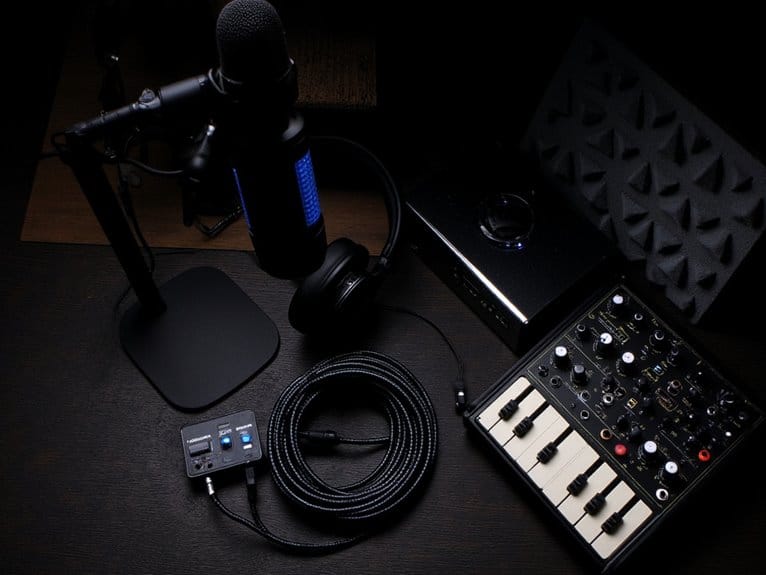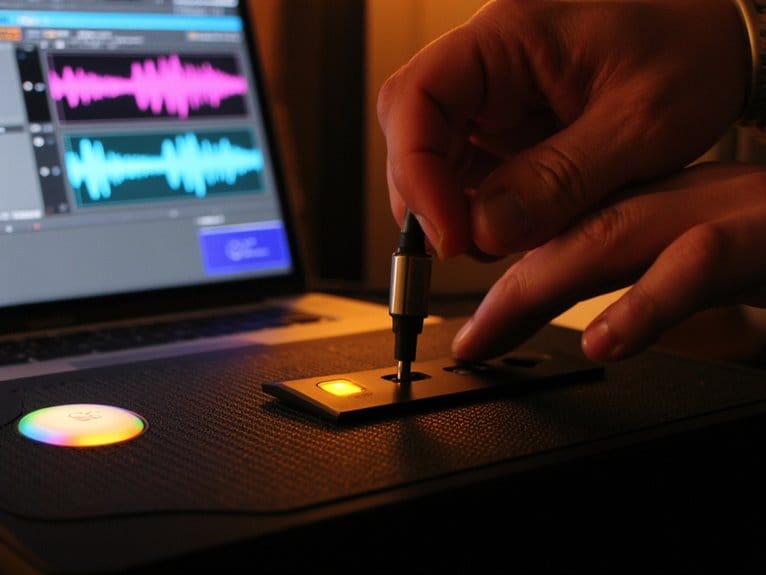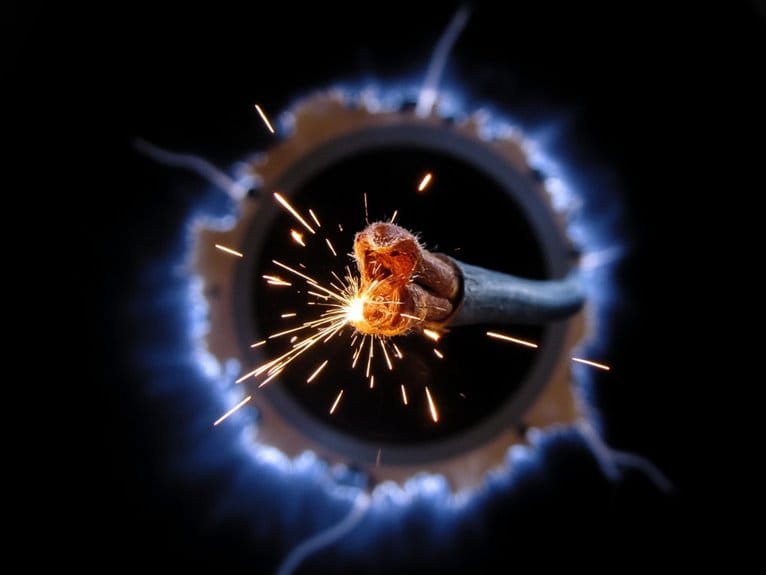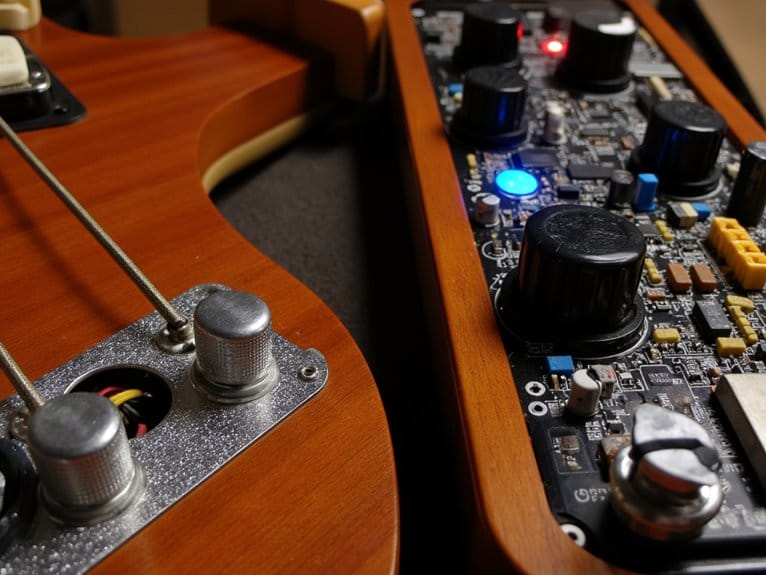Home Recording – Essential Tools and Equipment
You’ll need five core components for professional home recording: a quad-core computer with 16GB RAM running DAW software like Ableton Live or Pro Tools, an audio interface with quality preamps and converters to bridge analog instruments to digital, dynamic or condenser microphones with pop filters and shock mounts, near-field active monitors for accurate mixing decisions, and MIDI controllers for hands-on creativity and transport control. These fundamentals work together seamlessly, though selecting the right specifications for your specific needs requires understanding how each component affects your workflow.
We are supported by our audience. When you purchase through links on our site, we may earn an affiliate commission, at no extra cost for you. Learn more.
Notable Insights
- A quad-core CPU with 16GB RAM and SSD storage provides the foundation for professional home recording setups.
- Audio interfaces bridge analog instruments to digital workstations, enabling multi-track recording with quality preamps and converters.
- Dynamic microphones handle loud sources while condenser mics excel for vocals and acoustic instruments in home studios.
- Active near-field monitors with built-in amplifiers deliver accurate sound reproduction for mixing and mastering decisions.
- MIDI controllers enhance creativity through hands-on control of DAW functions, transport controls, and parameter manipulation.
Computer and Digital Audio Workstation Setup
The foundation of any successful home recording setup starts with your computer and Digital Audio Workstation, which I’ll break down into the essential components you’ll need without getting lost in the technical weeds.
Your computer compatibility hinges on having at least a quad-core CPU running 2.4 GHz, though I’d recommend bumping up to an Intel i5 or AMD Ryzen 5 for smoother performance with virtual instruments.
A solid quad-core processor at 2.4 GHz minimum ensures your DAW runs smoothly, but upgrading to i5 or Ryzen 5 delivers better virtual instrument performance.
You’ll want 16 GB of RAM and an SSD with 250 GB minimum storage, since traditional hard drives will slow you down considerably. Building your own PC gives you complete control over specifications and provides enhanced creative freedom with a custom setup tailored to your exact production needs.
For software selection, Ableton Live excels at electronic music production, while Pro Tools remains the industry standard for recording live bands, and most DAWs offer free trials to test workflow compatibility. Most audio interfaces provide multi-platform compatibility with both Mac and PC systems, ensuring your hardware investment will work regardless of your chosen operating system. When choosing between operating systems, Mac systems provide better stability and integration for audio production, while PC builds offer more customization options and budget-friendly configurations.
Your choice between ASIO vs. WDM drivers will impact recording quality and session management, with ASIO providing lower latency and better performance for serious recording tasks.
Audio Interface for Professional Sound Quality
While your computer handles the digital processing, an audio interface serves as the essential bridge between your analog instruments and microphones and your DAW, transforming those acoustic vibrations into pristine digital recordings that’ll make or break your final mix.
Different audio interface types offer varying capabilities, from simple USB units to professional Thunderbolt systems with superior bandwidth and lower latency.
Sound quality depends on four critical components:
- Preamp quality – determines your signal’s clarity and noise floor
- Converter specifications – affects transparency between analog and digital domains
- Dynamic range – captures soft whispers and loud crescendos without distortion
- Connectivity options – influences your setup’s expandability and routing flexibility
When evaluating interfaces, latency performance stands out as a critical metric that directly impacts your recording workflow and real-time monitoring experience.
Audio interfaces also enable multi-track recording capabilities, allowing you to capture multiple instruments or vocalists simultaneously for more complex productions.
I’ve found that investing in quality converters and preamps pays dividends in cleaner recordings and reduced mixing headaches down the road.
Microphone Selection and Recording Accessories
Once you’ve secured a quality audio interface, choosing the right microphone becomes your next critical decision in capturing professional-sounding recordings that’ll translate well across different playback systems.
Dynamic microphones, with their lower dynamic sensitivity, excel at handling loud sources like guitar amps and drums without distortion, while condenser mics offer exceptional detail for vocals and acoustic instruments. Ribbon microphones produce a mellower sound that works particularly well for specific musical genres and acoustic recordings.
Understanding microphone polarities-whether cardioid, omnidirectional, or bidirectional-helps you control ambient noise and focus on your intended sound source.
Don’t overlook essential accessories: pop filters eliminate plosive sounds during vocal sessions, shock mounts isolate mechanical vibrations, and sturdy mic stands guarantee consistent positioning throughout your recording process. When building your microphone collection, consider that affordable options exist alongside pricier alternatives to suit various budget requirements and recording applications.
Monitoring Equipment for Accurate Sound
Recording crystal-clear audio through your carefully selected microphone setup means absolutely nothing if you can’t accurately hear what you’ve captured, and that’s where proper monitoring equipment becomes the foundation of every mixing and mastering decision you’ll make.
Understanding different monitor types helps you choose wisely for your space and budget:
- Active monitors include built-in amplifiers, simplifying setup while delivering reliable performance that’s perfect for home studios.
- Near-field designs minimize room influence, making them ideal when acoustic treatment isn’t extensive or professionally installed.
- Two-way configurations with dedicated woofers and tweeters provide excellent frequency separation for most home recording applications.
- Frequency response ranges like 40Hz-35kHz guarantee you’re hearing everything from deep bass to sparkling highs accurately.
I’ve learned that monitor familiarity through consistent reference track listening calibrates your ears better than constantly switching between different speakers. Many engineers also invest in monitor controllers that provide enhanced audio transparency and precise signal routing capabilities for professional monitoring setups. Adequate headroom prevents distortion and maintains clarity when monitoring at higher volumes during critical listening sessions. Investing in quality headphones for guitar amp can also enhance your listening experience, allowing for more detailed monitoring without disturbing others. Additionally, using headphones allows for a more intimate connection with the nuances of the mix, which can be particularly beneficial during the tracking phase. Ultimately, blending both speaker and headphone listening can provide a well-rounded perspective on your sound.
MIDI Controllers and Studio Environment Optimization
How can you transform your digital audio workstation from a mouse-clicking marathon into an intuitive, hands-on creative experience that mirrors traditional studio workflows? The answer lies in selecting the right MIDI controller that matches your production needs and optimizing your studio environment around it.
MIDI functionality extends far beyond simple note input, offering aftertouch sensitivity, transport controls, and real-time parameter manipulation through knobs, sliders, and XY pads.
When considering controller portability, compact units like the Akai MPK Mini Mk3 excel for mobile producers, while full-sized weighted keyboards provide realistic piano feel for composition-focused work. Professional producers often benefit from feature-rich models that include semi-weighted keys with aftertouch and zoned settings for triggering multiple instruments simultaneously. Controllers evaluated on specific performance areas like beatmaking, composition, piano realism, and portability help determine the best fit for your particular workflow requirements.
Your controller arrangement should minimize physical strain while maximizing workflow efficiency, with automatic DAW mapping reducing setup complexity and allowing seamless integration between hardware and software components.
On a final note
You’ve got the foundation now-a capable computer with reliable DAW software, an audio interface that captures professional-grade recordings, microphones suited to your specific needs, and monitoring equipment that reveals accurate sound reproduction. Add MIDI controllers for enhanced workflow efficiency, optimize your recording environment through acoustic treatment, and you’ll transform any space into a functional home studio that delivers results matching commercial facilities.







